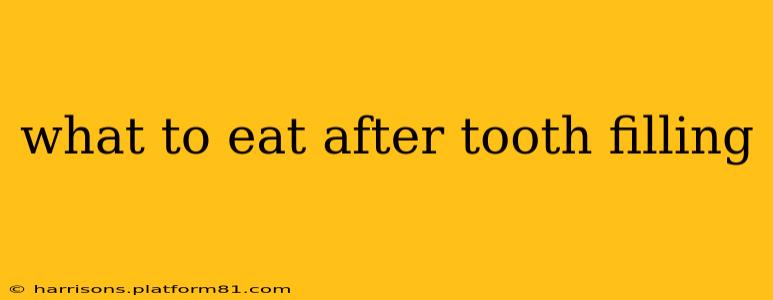Getting a tooth filling is a common dental procedure, but knowing what to eat afterward is crucial for a comfortable recovery and preventing complications. The immediate hours and days following the procedure are key for allowing the filling to properly set and for your mouth to heal. This guide will cover the best foods to consume, those to avoid, and answer some frequently asked questions about post-filling dietary restrictions.
What should I eat immediately after getting a filling?
The first few hours post-filling are critical. Your mouth will likely be numb, so it's essential to avoid anything that could cause injury. Stick to soft, cool foods that require minimal chewing. Think:
- Yogurt: Provides protein and calcium for healing. Choose plain varieties to avoid added sugars.
- Applesauce: Smooth and easy to swallow.
- Mashed potatoes: A comforting and nutritious option.
- Oatmeal: Easy to digest and provides fiber. Make sure it's cooled down.
- Scrambled eggs: A good source of protein, but ensure they are soft and well-cooked.
- Smoothies: Blend fruits, vegetables, and yogurt for a nutrient-rich meal. Avoid anything with seeds or hard chunks.
What foods should I avoid after a tooth filling?
Certain foods can interfere with the setting of the filling or irritate the sensitive area. It's best to avoid these for at least 24 hours, and even longer if you experience any discomfort:
- Anything extremely hot or cold: Temperature extremes can cause sensitivity and pain.
- Sticky foods: Candy, caramel, and gum can pull at the filling and dislodge it.
- Hard foods: Avoid anything that requires excessive chewing, like nuts, hard candies, and popcorn, as this can damage the filling or the surrounding teeth.
- Chewy foods: Tough meats and bagels can also put stress on the filling.
- Foods that require excessive biting: Avoid biting into whole apples or carrots.
How long should I wait to eat normal food after a tooth filling?
Most dentists recommend waiting at least 24 hours before returning to your normal diet. However, listen to your body. If you experience any pain or discomfort, stick to softer foods for a few more days. If you have any concerns, always consult with your dentist.
Can I eat crunchy foods after a tooth filling?
It's generally recommended to wait several days, or even a week, before consuming crunchy foods. This allows sufficient time for the filling to completely set and your mouth to heal completely. Starting with softer crunchy foods, like lightly toasted bread, and gradually increasing the hardness is a sensible approach.
What if my filling hurts after I eat?
Mild discomfort is normal, especially in the first few days after the filling. However, persistent pain, throbbing, or sensitivity to hot or cold foods can indicate a problem. Contact your dentist immediately if you experience any significant discomfort. They can assess the situation and provide appropriate treatment.
Is it okay to eat sweets after a filling?
While there is no absolute ban on sweets, it's advisable to minimize your intake, especially in the days immediately following the procedure. Sugary foods contribute to cavities and can exacerbate any lingering sensitivity. If you must indulge, choose sweets in moderation and rinse your mouth thoroughly afterward.
Remember, everyone heals at a different pace. Listen to your body, pay attention to any discomfort, and follow your dentist's specific post-operative instructions. A well-planned diet can significantly contribute to a smooth and speedy recovery after getting a tooth filling.
